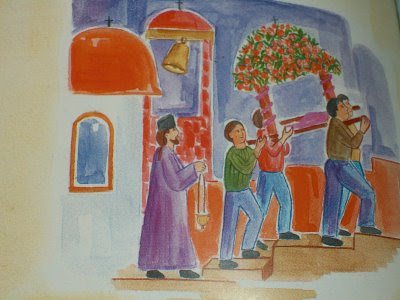
By Daniel Manzuk
It is a tragic fact that today Holy Saturday is viewed by many as an unimportant “day off” between the sorrow of Good Friday and the joy of Pascha. This is absolutely false. That view negates the essential link between the despondency of Good Friday and the ecstasy of Pascha. Holy Saturday is that indispensable link between Christ’s death and Resurrection. It is on Holy Saturday that we commemorate Christ’s conquest of death, which is sealed through the Resurrection. It is a day centered on a mystery beyond our comprehension. Christ is dead, His body lies in a tomb. Yet, at this moment of Death’s apparent victory over Life, Death is being put to death. Christ’s soul, as with every soul to that time, descends to Hades. Yet His soul is unlike any other. He is both God and Man. Hades has no power over Him. It tries to hold Him, as it has held every other soul since Adam and Eve, and fails. The Life that is in Christ the Life-giver, bursts upon the darkness of Hades like a searchlight in a small dark closet. The power of Hades is destroyed, not only over Christ, but also over His faithful subjects, us. The combination of the sight of Christ lying bodily in the tomb, yet knowing that He is simultaneously destroying death, creates an atmosphere of joyful sorrow, (unique to Orthodoxy) which compels us to “keep silent and in fear and trembling stand pondering nothing earthly minded. …” (Cherubic Hymn of Great and Holy Saturday).
This atmosphere blossoms in the Holy Saturday Liturgy, one of the most beautiful services of the year. The service begins as Vespers, with the Church arrayed in dark colors. The hymns of the “Lord I Call” speak of Hades grieving over its defeat at the hands of the “man born of Mary,” each hymn ending with the announcement of the coming Resurrection. After the Entrance, lessons from the Old Testament are read recalling salvation history from Creation through the Exodus and Holy Youths in the furnace. During this time in the ancient Church, the Catechumens were baptized in anticipation of Pascha; experiencing Christ’s death and resurrection through the Sacrament, as expressed in the Epistle of the day, which is also the Epistle of the Sacrament (Rom. 6:3-11). After the Epistle, to the joyous refrain “Arise O God, judge the earth, for to Thee belongs all the Nations,” the dark colors are replaced by white. The priest comes out dressed in white and scatters laurel leaves, bay leaves, and flower petals about the Church, as a sign of the impending victory and joy. Hades is on the ropes, Christ is conquering Death by His death, the Resurrection and eternal life are just around the corner. In token of this, the Gospel which follows makes the first proclamation of the Resurrection. Yet Christ remains in the grave. The joyful sorrow persists, evoked in the Hymn to the Theotokos: “Do not lament me O mother, seeing me in the tomb, the son conceived in the womb without seed. For I shall arise and be glorified with eternal glory as God…” This joyful sorrow will only become pure joy in the Resurrection.
For it is only through the Resurrection that Christ’s victory is complete. On Good Friday Christ became the ultimate, pure, blameless, and sinless lamb, sacrificed for us, washing away our sins with His blood. On Holy Saturday His soul enters Hades and obliterates it. Yet if He remains bodily in the grave, Death still wins, for He remains physically dead, making our faith in St. Paul’s words worthless (1 Cor.15:12-20). But Christ is both God and man. And God cannot die. To make His victory complete, He does what no one is supposed to do, He returns from the dead, “making for all flesh a path to the Resurrection from the dead” (Anaphora of the Liturgy of St. Basil).
From His betrayal by Judas, through His humiliating death and His descent to Hades, and culminating in His glorious Resurrection, the whole of the Paschal weekend is one interrelated series of events which brings about our salvation. Each event had to occur for the one before and after to have any meaning. This is His, and our Passover, (which in Greek is Pascha) from death to Life, from sin to salvation. And in this glorious campaign of salvation, Holy Saturday is the day the battle is fought, which results in the ultimate victory of Pascha. Holy Saturday is the pivotal day in the Paschal celebration. The day sorrow begins to transform into joy. The path from death to life is being laid. This is an event not to be missed. There would be no victorious Resurrection without Christ’s descent into and defeat of Hades, and for that reason there can be no true celebration of Pascha without the celebration of that victory in Hades, which is Great and Holy Saturday.
So as each of us will, God willing, experience this Passover from death to Life, we should feel compelled to accompany our Lord as He paves the way. To emulate the Myrrh-bearers who stayed faithful and kept vigil over Him, rather than the disciples who fled. So that we, like the Myrrhbearers, may be the first to receive the news of the Resurrection, and join with St. John Chrysostom in saying:
“O Death, where is your sting? O Hell, where is your victory? Christ is risen! and you are overthrown. Christ is risen! And the demons are fallen. Christ is Risen! And the angels rejoice. Christ is Risen! And Life reigns. Christ is Risen! And not one dead remains in the grave.”
For Christ, being risen from the dead, is become the first fruits of those who have fallen asleep. To Him be glory and dominion unto ages of ages. Amen.
April 2008 issue of The Word magazine.